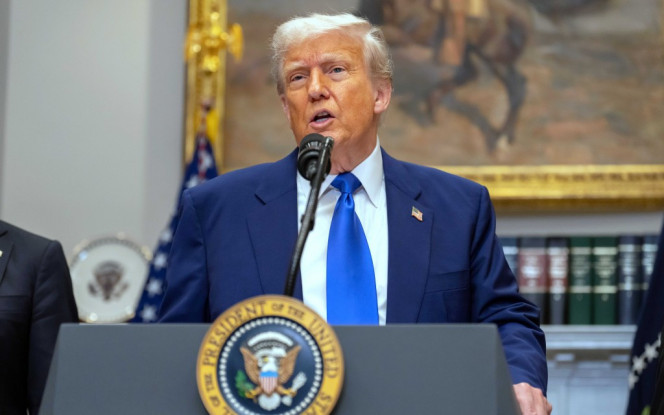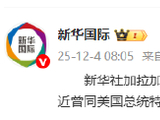No Change in US-China Policies; Xi Meets With Brazilian President Lula; Panama Excludes China in New Railway Project; US Sends AI Chips to Middle East; China Incorporates AI in Education; Daily Updates Within China

U.S.-China Trade Dialoge
The recent dialogue between the United States and China continues to feature prominently in global news cycles. In one such instance, Trump’s remarks on trade highlighted the benefits of what he termed "unification and peace." The acknowledgment that open markets are advantageous for both countries reflects a positive outlook. However, official U.S. responses assert no change in policy concerning China or Taiwan, indicating a carefully measured stance. This divergence in tone points to different strategic priorities; while the U.S. promotes policy stability, China's potential willingness for market openness suggests a pivot to more inclusive economic policies.
On the publication front, Sing Tao focuses on the positivity of potential agreements, emphasizing harmonization that could ensue from such economic decisions. This narrative aligns with China's broader diplomatic strategy to project an image of cooperation and peace.
The Trade War's Legacy and Future Corridors
The background of tariffs and past trade disagreements still loom large, with commentary from The New York Times touching on the limitations of Trump-era policies. The Times critically reviews the sustainability and strategic foresight of significant tariffs, pointing out that long-term consequences include market volatility and hindered economic partnerships. This narrative aligns with a view that seeks progressive re-engagement with trade partners previously strained by protectionist policies.
In exploring the continuation of strategic interests, we see a narrative of circumspection aimed at balance rather than outright confrontation, a concept worth noting going forward as mutually beneficial trade agreements could change the current trajectory of economic relations.
China’s Expanding Influence in the Americas
China's geopolitical maneuvers in regions such as Latin America were underscored by New York Times’ coverage of meetings with Brazil’s Lula. The discussion surrounding China’s outreach to Latin America is indicative of its long-term strategic interests. By showing goodwill, China perhaps aims to solidify its economic and political partnerships in a resource-rich region. Here, diplomacy is at the service of economic strategy, unifying economic efforts and diplomatic overtures to strengthen China's global influence.
Contrasting with earlier regional exclusion under perceived U.S. influence, China's approach symbolizes a pivot towards softening regional barriers. The New York Times narrative underscores this as a clear showcase of soft power implementation through economic engagement.
Infrastructure Battlegrounds: The Belt and Road Initiative
The Belt and Road Initiative, a hallmark of China's global strategy, has faced setbacks in certain areas, as seen with the news from Panama excluding Chinese participation in a new railway project. This decision underscores recent regional tensions and shifting alliances. Panama's move to involve the UK and US for technological and financial support instead highlights a broader competition for influence in strategic infrastructure projects.
This development underlines both China's evolving foreign policy landscape and Panama's reassessment of its strategic alliances, seeking closer ties with Western countries.
The Role of AI in U.S.-Middle East Relations
In recent news, President Trump's administration has taken significant steps to strengthen ties with the Middle East through the provision of U.S.-designed AI chips to companies in the region. According to a report by The Paper, the U.S. government plans to supply several million AI chips to G42, an artificial intelligence company in the United Arab Emirates (UAE). This move is seen as part of a broader strategy to boost economic cooperation and reinforce military and technological alliances in the region. White House officials, including AI and cryptocurrency head David Sacks, are negotiating a framework for these chip supplies under controlled circumstances, showing a shift from previous export limitations set by earlier U.S. policies.
The narrative from The Paper highlights a strategic pivot aiming to fortify U.S. influence and partnerships in the Middle East, contrasting with the prior administration's more restricted stance on AI technology exports. This initiative might reshape global AI military strategy, allowing Middle Eastern countries like the UAE to advance their domestic AI capabilities. Interestingly, OpenAI's CEO Sam Altman has expressed hope that such collaborations could alleviate computational shortages within the U.S. by partnering with advanced AI sectors abroad.
AI Integration in Education: China's New Guidelines
The Chinese Ministry of Education has recently published comprehensive guidelines to integrate AI into the primary and secondary school curriculums. As detailed in a report from CCTV News, these guidelines aim to develop a complete system for AI literacy education by 2025. The guidelines provide a framework for fostering interest and foundational understanding in elementary students, while focusing on technical principles and application in middle school and system thinking in high schools. This approach is designed to gradually build AI competencies across educational stages, preventing excessive dependence on technology and promoting balanced cognitive development.
CCTV's coverage emphasizes China's commitment to being at the forefront of AI education, ensuring students are not only exposed to technology but are also taught to critically analyze its societal implications. This initiative could significantly impact the global landscape by nurturing a generation that is well-versed in AI, potentially driving future innovations and ethical considerations in tech development worldwide. The inclusion of AI education at such foundational levels reflects China's long-term planning for retaining its competitive edge in the field.
Cultural and Social Dynamics
The recent modifications in the "eight regulations" (CCTV), as highlighted by CCTV News, reveal how China's internal policies can have far-reaching impacts on both governance and societal behavior. This piece emphasizes party and governance rectitude as vital forces in leading societal change, hinting at the pervasive reach of political directives in everyday life. By tightening party discipline and governmental conduct, China aims to mold societal norms and values, ensuring that party alignment with national objectives permeates all levels of society. CCTV’s narrative aligns with the typical state broadcast messaging that emphasizes unity and coherence under party leadership.
In stark contrast, an incident in Yunnan's Weixin County reported by The Paper underscores the nuanced tensions between local governance and public actions, revealing the social undercurrents still prevalent in some regions. The story of unauthorized individuals impersonating police serves as a metaphor for deeper-rooted issues of authority and compliance. The incident, handled with formal police procedure, hints at the importance of enforcement and respect for legal symbols in maintaining public order, a critical element in regions maintaining a delicate balance between traditional practices and modern regulatory frameworks. It reflects local challenges that can arise when citizens blur boundaries confounding order and governance within communities.
Technological Advancements and Infrastructure
Guangdong’s ambitious water network plan as reported by The Paper demonstrates China's infrastructure prowess, showcasing the intersection of state ambition and regional development. The implementation of a modern water network highlights a decade-long commitment to creating an interconnected system that will integrate local and national grids. By aiming for completion by 2035, China underscores its devotion to long-term infrastructural growth conducive to societal welfare and economic productivity, echoing national goals for sustainable development. Such initiatives are designed to set benchmarks not only regionally but also globally in terms of technical standards and environmental harmony.
The ongoing integration and consolidation of police new media resources, as The Paper underlines, illustrates a methodical approach to enhancing official communication channels for governance transparency. Independent accounts are phased out in favor of centralized platforms, emphasizing the state’s pivot towards streamlined, authoritative information dissemination. By consolidating these resources, the government seeks to bolster reliability and control, balancing modernity with a perennial objective of message consistency. This strategy presents a model of how public sector entities can retain control over narrative through digital transformation.
Agriculture and Economic Diversification
Technological integration into traditional sectors is another focal point, as detailed by a CCTV report on "agri-tourism" and modern agriculture ventures. By capitalizing on flower cultivation in places like Guizhou and Guangxi, the report showcases how aesthetic and economic values can synergize, creating lucrative opportunities through e-commerce and smart agriculture. This trend toward digital and agricultural integration is essential for China’s rural revitalization strategy, demonstrating sustainability while revitalizing traditional economic bases with innovative technology and market strategies.
Internationalization of Chinese Education and Influence
The academic movements, such as Zhou Qisheng joining Tongji University (The Paper), reflect China’s global scientific ambitions. Zhou’s appointment signals an ongoing effort to attract and cultivate talent capable of propelling Chinese academia onto the global stage. It suggests an increased willingness of Chinese institutions to collaborate internationally, inviting diverse perspectives and strengthening China’s place in the global educational landscape. Such developments not only elevate the academic ecosystem internally but also enhance China’s soft power internationally.
Transnational Cooperation in New Economic Sectors
Finally, the dynamics surrounding the China-Latin America and Caribbean States forum exemplify how economic collaborations are evolving (CCTV). The burgeoning dialogue focuses on sustainability and new economies, marking a departure from traditional trade domains to sectors such as green economy and digital economy. This extension into new territory speaks to China's diplomatic agility in capitalizing on mutual strengths, facilitating comprehension of varied economic landscapes, and positioning itself as a strategic partner internationally. As these regions combat developmental disparities, China's engagement provides a model for fostering inclusive growth, blending resource wealth with technological acumen.



